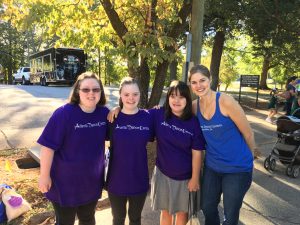 What began as a “sure I can do that” weekend workshop has developed into something much bigger than I ever imagined. The Foster-Schmidt Dance Academy (now named Physio-Jazz) has become my passion, my drive, my puzzle, my challenge, and my inspiration. I never expected that classes for students with Down syndrome would be so rewarding and yet, it’s the most wonderful surprise of my life.
What began as a “sure I can do that” weekend workshop has developed into something much bigger than I ever imagined. The Foster-Schmidt Dance Academy (now named Physio-Jazz) has become my passion, my drive, my puzzle, my challenge, and my inspiration. I never expected that classes for students with Down syndrome would be so rewarding and yet, it’s the most wonderful surprise of my life.
Why did I decide to develop the program? Though I’d love to have a grand story, I don’t: It just found me unexpectedly. I have a family friend (Vince) with a son (Jonas) who has Down syndrome. I met Jonas in 2006 when I helped with a tennis workshop that Vince had launched for students with Down syndrome. I really enjoyed the experience and when Vince asked me to do a dance workshop in Atlanta, I said “sure I can do that”, not thinking much about it. It would be fun.
We held three weekend workshops over the course of a 2 year period and then I opened Atlanta Dance Central. At ADC, I had the opportunity to expand the program to provide a weekly class and so I decided to offer an art, dance, and music therapy 6-week class because . . . it would be fun.
(Fun Fact: I had 6 students in the 6-week class. Several of them are now members of the Foster-Schmidt Dance Company 7 years later.)
The “fun” class was not what the parents wanted. They wanted a “real dance class” with a recital dance and technique. I was overwhelmed with the feeling that I knew NOTHING about that. I offered this program because it would be fun but now this was getting serious. They believed that I could do it but I was unsure. I’m out of my league, I thought. I don’t want to mess this up.
So I did what I always do when I am unsure about something. I began an obsessive search to find books or materials that would tell me how to do it: An instruction manual, a syllabus, a program, a person – anything or anyone who could tell me what to do? These students and parents were counting on me and I wanted to provide the class that they wanted.
Unfortunately, my quest for information came up short. Boston Ballet (who had a strong developed program) was working on a resource but it wasn’t available yet. There were books with the characteristics and learning styles of students with Down syndrome, but there wasn’t a clear cut, this-is-how-you-do-it, syllabus. It was up to me to figure out how to apply the information that I did have to the dance classroom.
This became one of the biggest challenges I ever faced as a teacher and my love-affair with puzzles and problem solving was ignited. I was going to figure this out and create a dance class for students with Down syndrome using my own intuition and the limited information that I had as a guide. I was going to try my best because that was really all that their parents were asking of me . . . to give it a try . . . to say Yes.
My classroom became somewhat of a science lab, where we would try something new (an experiment) and see what happens. Note the results and evaluate. Continue doing it or scrap it and try something new. There were just as many failed experiments as successful ones. Each one taught me something new and made me grow into a much better, more attuned teacher than I ever thought I would be. I found this process fun, invigorating, exciting, and inspiring and most importantly, I found that I was making a difference. Our once-a-week dance class was giving these students stronger muscles and coordination while also developing their focus, social skills, and appropriate behaviors.
Ten years later, I’m so thankful that I said yes to the weekend workshop and that I accepted the challenge to develop a “real dance class” at ADC. At that time, I had no idea that parents of children with Down syndrome were hearing NO all the time. My “Yes” to trying was all they needed. They didn’t need me to be perfect and to have all the answers.
And now that is my number one rule for my students in class: Try your best.